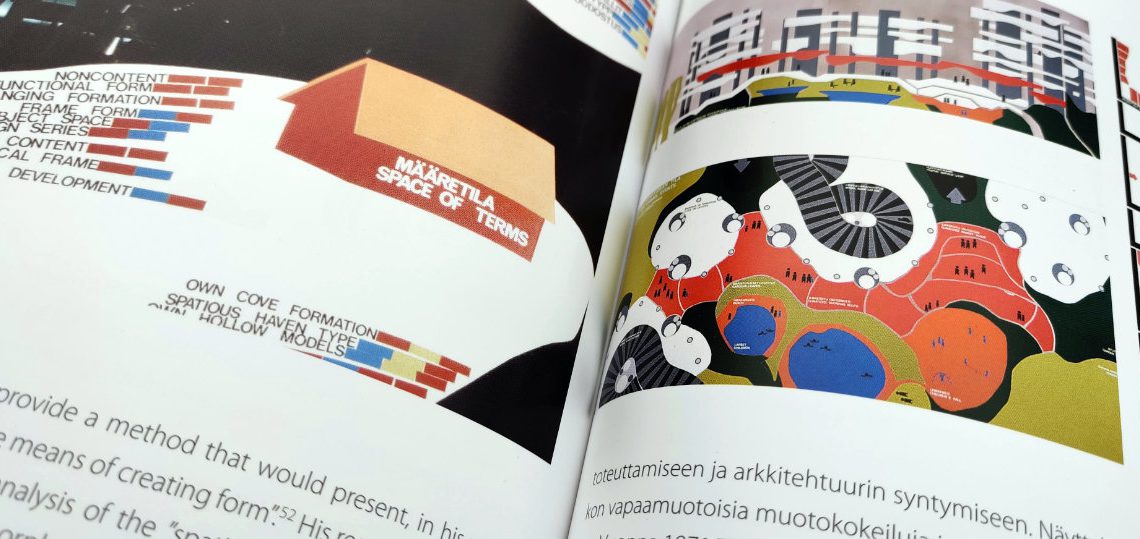Reima Pietilä “aware of everything present and everything taking place” – Interview with Kaisa Broner 10.11.2019 – Posted in: News
Reima Pietilä (1923–1993) is one of the most well-known and absolutely one of the most original Finnish architects. The new book Visions of Architecture: Reima Pietilä and the Meanings of Form by Kaisa Broner gives a fresh outlook towards Pietilä’s theoretical thinking and the principles of his primordial language of form. Anni Vartola interviewed Kaisa Broner about her new Reima Pietilä book. The English translation is by Gareth Griffiths and Kristina Kölhi.
Anni Vartola: How did you initially get to know Reima Pietilä, and what kind of a person was he?
— Kaisa Broner: Asking me to describe Reima Pietilä as a person is very difficult, but I’ll try to give a response based on my own personal recollections. It would be impossible, however, to create any comprehensive understanding of his complex personality through just a few examples.
I got to know Reima and Raili Pietilä already during my studies, sometime in the early 1970s. A fellow student working in the Pietiläs’ office (if I remember correctly, located at that time in a wooden building on Korkeavuorenkatu, Helsinki) invited me to visit the office and introduced me to them because I had expressed an interest. It was at a time when there was a lot of controversy over the architecture of Dipoli, and I myself found it a very enigmatic and interesting building. I don’t recall what we would have talked about with Raili or Reima, but somehow the only thing I remember is Reima’s gaze. It has always seemed to me that he was intensely observing his surroundings, as if aware of everything present and everything taking place.
Then, at some point, maybe a couple of years later, I was looking for a job and called the Pietiläs’ office. Reima answered the phone and, if I remember correctly, he was very positive about my inquiry, but told me that there was no work in their office at that time. We kept chatting for a while, about this and that, and I felt the communication went well. As I recall, he asked me something about the situation regarding architectural studies in Otaniemi and seemed genuinely interested. At that time, I had edited the architecture students’ journal a-lehti [Arkkitehtiopiskelija], in which we students expressed some pretty radical statements. I myself wrote several articles about the French student revolution and the events of Paris in 1968. Paris was my second home at that time.
he never gave the impression of being in a hurry or having something more important to do
The next recollection I have of Reima is from the time I was working on my diploma thesis in architecture. It was a written study dealing with the problematics of urban renovation and preservation in Paris. In the 1970s, a very drastic and politically motivated demolition of old buildings and areas and the reconstruction of new ones, in fact totally different environments, took place, although some results had already been achieved in the area of urban preservation, for instance the ratification in 1970 of the conservation plan for the historical district of Marais on the Paris heart. When I showed Reima my thesis and its table of contents, he immediately understood the structure of the work – what was essential and important. He also recommended that I continue the diploma thesis directly as a licentiate or doctoral thesis and urged me to apply for a scholarship for that purpose. I remember very well Reima’s encouraging and inspiring attitude. Whenever we met, he never gave the impression of being in a hurry or having something more important to do. And every time I went to visit Raili and Reima Pietilä, even in later years, I left there feeling somehow spiritually richer.
After my diploma thesis I returned to Paris and worked there for a few years in an architectural office. Sometime around 1976–1977 Reima contacted me saying that he and Raili were coming on an excursion to France and would like to explore in particular the new cities in the Paris region. He asked if I could be their guide. So, I spent at least a couple of days with the Pietiläs, accompanied by their daughter Annukka. I also attended a get-together at the studio of Tuulikki Pietilä and Tove Jansson at the Cité des Arts. I have a recollection that Reima was inspired to talk at length to me about all his impressions from the excursion, the new urban environments and his own architectural thinking, which of course I was very interested in hearing about – until, that is, Tuulikki eventually scolded us as our conversation just went on and on and took up too much time.
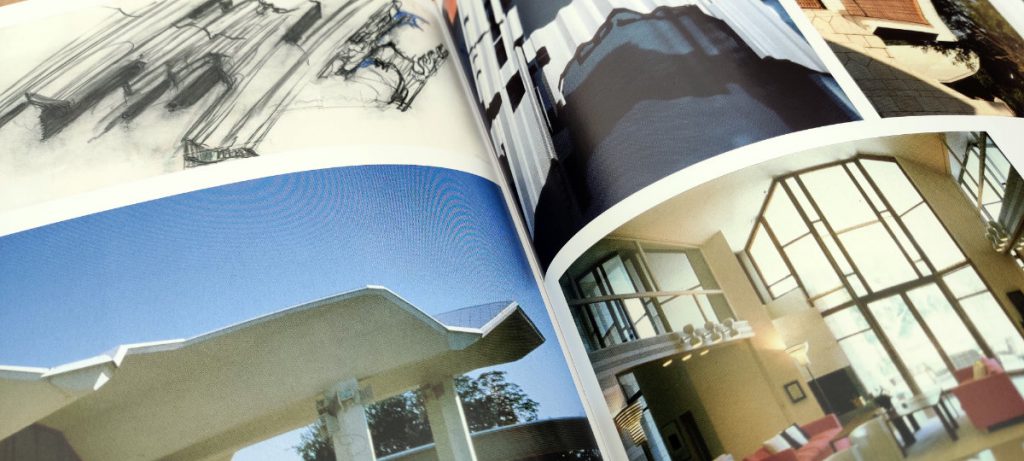
Reima Pietilä was indeed a keen conversationalist and writer. He was well aware of the topical trends in architecture as well as philosophy and the current state of social debate. He published numerous articles on his own personal viewpoints throughout his career, especially in the Finnish Architectural Review and Arkkitehtiuutiset, but also actively participated in the international discourse, such as CIAM in the 1950s and, following its decline, Team 10 up until the 1970s. Le Carré Bleu was one of the forums where he published his theoretical writings in both English and French. During the 1950s and 1970s, this journal – founded in Finland – represented the international avant-garde. Reima, however, most certainly followed his own path. Still, he was constantly analysing what was happening in the field of architecture in Finland and elsewhere, and was always open to communications. It was as if he needed it, providing stimulus to his own architectural thinking and creative work.
Pietilä’s avant-garde was – and is – more of a philosophical or spiritual quality than something merely connected to the architectural forms
Another special recollection: in the Pietiläs’ living room was a large, low table that people often sat around and chatted during visits. On the table were always plenty of books, the latest architecture books, but also philosophy and other topical issues. I remember, for example, that I first heard the name Jürgen Habermas sometime after the mid-1970s, specifically from Reima. A couple of years later, while I was studying at Columbia University in New York, Habermas was a hot name and was also mentioned in lectures there.
In Finland Reima Pietilä was ahead of his time, representing a genuine avant-garde, even though people did not understand that during his lifetime. However, his avant-garde was – and is – more of a philosophical or spiritual quality than something merely connected to the architectural forms. I say spiritual because it embodies intuitive creativity and freedom. That freedom is not arbitrary but rather attaches itself to culture and nature, in other words, to the local context through a conscious, conceptual thinking. His architecture cannot be imitated, but his approach or method can be learned from. All people doing creative work can draw inspiration from it for their own way of working.
There are a lot of books and research on Reima Pietilä and the Pietiläs’ architectural production. What new aspects does your book bring to the prevailing view of Reima Pietilä? What in your view makes Reima Pietilä such an endlessly intriguing architect?
— I would say that my interview with Reima Pietilä in 1987, now published for the first time in its entirety, is a noteworthy document that opens up new or little-known perspectives on his personality as an architect and human being. I am referring, for instance, to the shamanism he spoke about during the interview. Manifested in the interview is Reima’s comprehensive architectural thinking, as well as his special way of working – his intuitive imagination or “shamanism” as well as “verbal sketching” and “image sketching”. I have called it a heuristic method, and it is the central topic not only of the interview, but also my accompanying essay.
the Pietiläs’ architecture and its meanings are a veritable goldmine for research
The richness and complexity of Reima Pietilä’s architectural thinking, as well as his theoretical activities, are outlined in the book in a way that is comprehensible to the reader. Similarly, the contextual backgrounds of Raili and Reima Pietilä’s architectural works emerge as central elements. I think these are among the book’s most important contributions, because Reima Pietilä was not always understood in his own lifetime. Raili and Reima Pietilä’s names, for example, are missing from many of the key history books of 20th-century modern architecture, even though such books otherwise comprehensively cover the architecture from the 1960s to the 1980s with its different tendencies and individual architects.
I have thought that specifically in the case of Reima Pietilä we see the hermeneutical problem in the writing of modern architectural history in the 20th century. Few authors have been willing, able or even dared to place him in the matrix of 20th century architectural development. I do not think there is any reason for such hesitation. Rather, it has been a question of misunderstanding or a lack of knowledge. Now, more than a quarter of a century since the death of Reima Pietilä, the issue is quite clear in terms of architectural history. There remains, however, still much to be explored, and the Pietiläs’ architecture and its meanings are a veritable goldmine for research. Actually, in this book I have tried to write a very concise portrayal, particularly of Reima Pietilä’s architectural thinking, architecture, working methods and significance.
Your book clearly shows how linguistically gifted Reima Pietilä was and the fundamental relevance the verbal thought process was to his architectural expression. I feel a great sympathy for all those who worked with the English translation of your book; it must have been extremely difficult to translate Pietilä’s original vocabulary into English. You yourself have worked a lot using foreign languages and in foreign cultures as an educator, writer and scholar. How do you see, from your own professional viewpoint, the relationship between language, culture and architecture?
— Reima Pietilä was indeed linguistically extremely talented. He coined neologisms in order to find the appropriate expression when he could not find them in his mother tongue, and he was also philosophically interested in the meanings of the language. He always kept a Finnish etymological dictionary at hand; it was like a bible to him, the “narratives” of which could inspire him, for instance, when sketching new architectural designs. Reima Pietilä saw the etymological meanings of language as archetypal expressions of culture.
Likewise, his way of forming sentences and concepts was very personal, and that made the translation work a challenge. The translations were edited several times and there were several translators involved. It took a lot of time and I participated closely in the process. This is virtually a must, because it is only the author themselves who can see if the translations into another language feel in accordance with the original and in that sense authentic. I am grateful to the translators and satisfied with the outcome.
culturally lasting architecture is always based on cultural archetypes
Your question about the relationship between language, culture and architecture is important. Language and culture belong together, there is no culture without language, and architecture is part of culture. In the fields of linguistics and cultural research, especially in structuralism, but also in other fields of humanities and social sciences, these connections have been, and continue to be, explored from different angles. I have studied the archetypal expressions of culture in reference to architecture. In fact, the same, specific inner deep structures which are distinguishable in a certain human community or society are manifested in both language and other authentic expressions of culture. Speaking of the theory of archetypes, one can distinguish universal archetypes and, on the other hand, one can talk about archetypes confined to a particular cultural sphere which I call cultural archetypes. The former are common to all mankind, they are the psychic structures of the collective subconscious. The latter are concerned with the inner deep structures of a culture, such as ethical and aesthetic values and symbolic meanings. I would assert that culturally lasting architecture is always based on cultural archetypes.
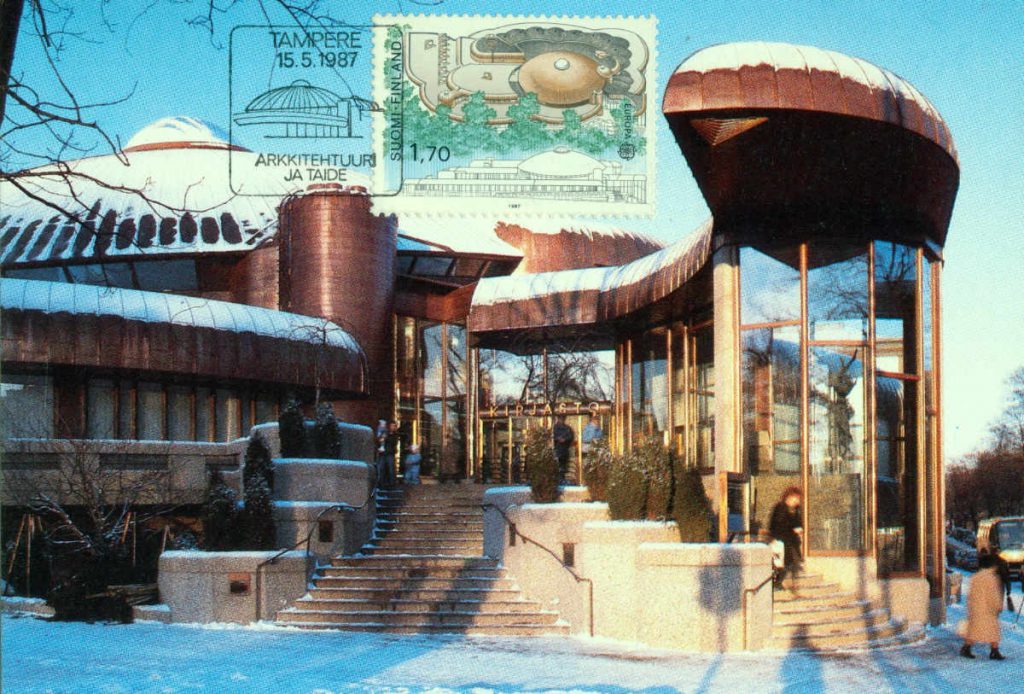
The most remarkable contribution of Visions of Architecture is your long and penetrating interview with Pietilä from 1987. How in your view does the year 1987 resonate with today’s architectural culture?
— The 1980s saw an economic boom in the west. By then, the harsh criticism of the modernism of the previous two decades had already been bypassed, particularly in regard to the principles of modernistic urban planning. In the 1980s architects were openly searching for something new.
Developing of urban preservation methods became topical in urban planning and redevelopment projects. There was also a lot of new construction going on, especially museums and other cultural buildings, albeit built with different criteria than those during the dominance of the International Style, which led to a reflection on cultural meanings related to architecture, especially the question of identity. That was the era of late modernism and postmodernism. History was again openly being explored, and inspiration was found from classical architecture and its theories. More was also being written about contemporary architectural theory than previously; this is always the case when a period of epistemological rupture occurs.
In Pietilä’s work, postmodern culture is manifested philosophically
But I want to point out straight away that the above description basically only applies to western countries in general and not specifically to Finland. A different atmosphere prevailed here. Your own doctoral dissertation aptly describes how the consensus among Finnish architects opposed postmodernism. Yes, there were some architects in Finland who cautiously tried the postmodern approach in their own work. Reima Pietilä was in my opinion one of them, even though he in principle always proclaimed the continuity of modernism. In Pietilä’s work, postmodern culture is manifested philosophically. He explored the context and identity of the place and committed his work to the temporal and morphological continuum of the location. He was not interested in the stylistic experiments of postmodernism and never cultivated historical quotes, but rather used numerous natural metaphors in his architecture – as concretely evident, for instance, in Dipoli and the Finnish Embassy building in New Delhi. The Metso library in Tampere, on the other hand, manifests ambiguous metaphors, including animal symbolism as well as temporal depth, in this case showing the influence of prehistoric visual images on architectural design.
n the 1990s, a demand for sustainable development emerged, and architects began to search for ecological solutions in building and urban design. This was a very important change of direction that still continues as we approach the 2020s. It is driven by an awareness of the seriousness of climate change and the urgency of change to the western lifestyle. Finding solutions does not just lie in the hands of individual citizens but requires global solutions as well as a number of structural decisions, for example in agriculture, which is one of the worst polluters due to its emissions.
from the 2010s onwards we will have a new kind of modernism, which he called “fourth modernism”
Thus, today’s atmosphere is quite different from that of the 1980s. How this is reflected in the architectural culture becomes evident in the attitudes of architects. The criteria of sustainable development – economic, social and cultural – steer design practices and building construction. The atmosphere of debate is somehow more serious and at the same time more open-minded, and, if I am not mistaken, there is also a more spiritual debate on values. So Reima Pietilä’s steadfast vision and prediction from 1987, that from the 2010s onwards we will have a new kind of modernism, which he called “fourth modernism”, in other words, a much more open-ended modern architecture than that of the 1980s, has probably come true.
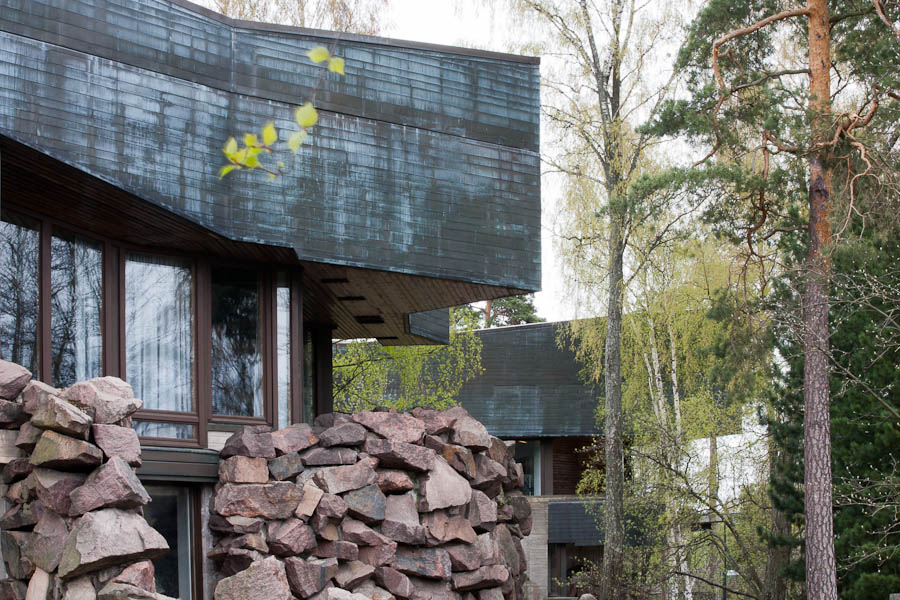
When reading your impressive analysis of Reima Pietilä and the significance of the Pietiläs’ architecture, I found myself thinking how exceptionally original and self-assuredly masterful Reima Pietilä’s architectural thinking was. At the same time, I also came to think how alarmingly homogenous the current generation of Finnish architects is. Our contemporary architecture seems to completely lack, for example, any experimental avant-garde. Do you share this viewpoint? And then again, why doesn’t the field of Finnish architecture have any more “shamans” – true originals – like Reima Pietilä?
— Reima Pietilä was extraordinarily creative and talented, a visionary architect, and there are not many like him in the history of western architecture in general. Raili Pietilä was also a creative and talented architect, and together they formed an excellent working partnership. Raili was more pragmatic and I understand she was to a great extent responsible for the running of their office. This gave Reima time to study and reflect on artistic and theoretical issues in architecture. Reima read and wrote a lot and initiated and participated in discussions on theory, which is quite rare in Finland.
Architecture cannot be divorced from social development
One can discern different periods in the history of architecture. Avant-garde trends seem to emerge at times of social upheaval and especially during a change in worldview, where new thinking emerges and becomes necessary. This is also reflected in architecture. For example, during the Renaissance and Baroque periods, a new paradigm emerged, just as it did with the emergence of the industrial society in the 19th century, and especially with the breakthrough of modernism in the early 20th century and subsequent decades, when many significant inventions were made in various fields. Architecture cannot be divorced from social development.
Our own time, at the turn of the 2020s, is once again something new, and one could say that a new worldview is taking shape. We are living in a so-called ubiquitous information society, with the rapid development of communication media, digitalisation and globalisation, but also climate change with all its threats. We are constantly seeing examples of what this development means for architecture, especially in the wealthy growth areas of post-capitalism. But what is it that we actually want to call today’s avant-garde? I would say that it should represent a way of thinking that includes the pursuit of the “good, beautiful and true”, both locally and globally. The avant-garde of architecture, however, lies not in proportions, as even a small house, if anything, can be avant-garde architecture. Ethical thinking and intent are essential. At the same time, we must remember Mies’s words that there is no need to invent new architecture every Monday morning. New types of architecture are created in new social situations, by asking new kinds of questions and responding with new thinking as well as with new technological developments.
But rarely do Finnish architects combine creative theoretical thinking with design, or at least they are not talking about it. Does the reason for this lie with society, for instance due to busy schedules and other pressures?
We still have, in my opinion, cutting-edge creative architects in Finland today. The international recognition for Helsinki’s new Oodi Library is one indication of that. But rarely do Finnish architects combine creative theoretical thinking with design, or at least they are not talking about it. Does the reason for this lie with society, for instance due to busy schedules and other pressures? Or is it that we have an ethos that does not allow for any thinking that diverges from the consensus, at least not in public forums? It should also be noted that relatively little new architecture is currently being built in Finland, as building rehabilitation, renovation and restoration already accounts for around 50% of the total volume of construction activity. On the other hand, one can also find interesting and creative theory-driven thinking with its own vanguard in the rehabilitation field.
If we look back over Reima Pietilä’s years as an architect, we can see how he constantly had to defend his work in public. It must have been hard, but fortunately he was willing to discuss and write. He possessed the typical Finnish stamina, sisu, and an inventor’s enthusiasm for following his own path. But then again, he was an extraordinary person and talented in a variety of ways. And I am happy that today it is especially the younger generation of Finnish architects that appreciates the works of Raili and Reima Pietilä. An example of this is the interview with ALA Architects in a recent edition of the Finnish Architectural Review 4/2019.
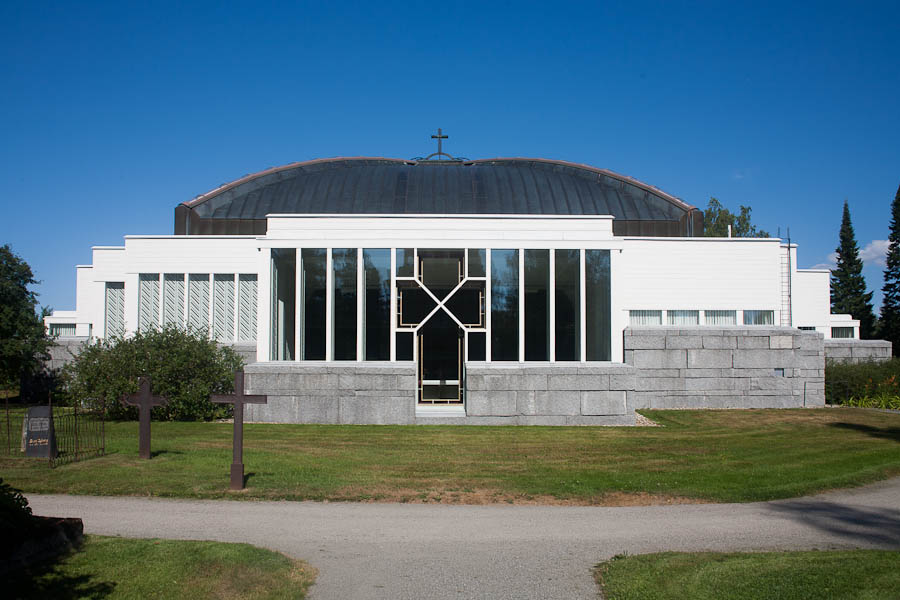
Your book Visions of Architecture is published by OKU Publishing, which is your own publishing company. What kind of books do you publish and what does the world of architectural literature look like through the eyes of a publisher?
— I founded this small publishing company together with my son Tilman Bauer, who currently is a doctoral researcher at Aalto University School of Business. OKU Publishing was deliberately established as a small publisher, and with no plans to become a large commercial enterprise. We will publish a book whenever a suitable work is offered. The topics of interest are naturally architecture, art and the social sciences. Academic theses in these fields may also be relevant. So, we will primarily publish non-fiction.
The level of mankind’s consciousness is manifest in literature
The traditional book industry has, of course, experienced some kind of crisis in the era of electronic media. Less printed books are sold, while e-publications have become more widespread. The present age is characterized by haste – haste in everything and everywhere – and electronic publishing can better meet the demands of such a time. News, thoughts, and images are instantly brought to readers worldwide. Haste also means less time than before for reading things unrelated to work.
But books have a purpose other than simply conveying knowledge; they inspire people to think, and provide a variety of experiences, from poetry to aesthetics and from exploring the different phenomena of life to philosophical reflection. The level of mankind’s consciousness is manifest in literature. I love books and I couldn’t imagine my life without them.
Architectural literature has its own special place in the world of books and although many journals in the field have had to be converted into e-publications for economic reasons, printed books still have a role to play. And yes, they still sell, despite the fact that publishing architecture books is quite expensive due to, among other things, the often abundant use of illustrations. Their editions are usually relatively small, which also increases the price per item (except some English-language books intended for global circulation). When attending the Frankfurt Book Fair this fall, I noticed that at least the classics of architectural literature are still on display.
Haastattelu: Anni Vartola, 2019.
English translation: Gareth Griffiths and Kristina Kölhi.
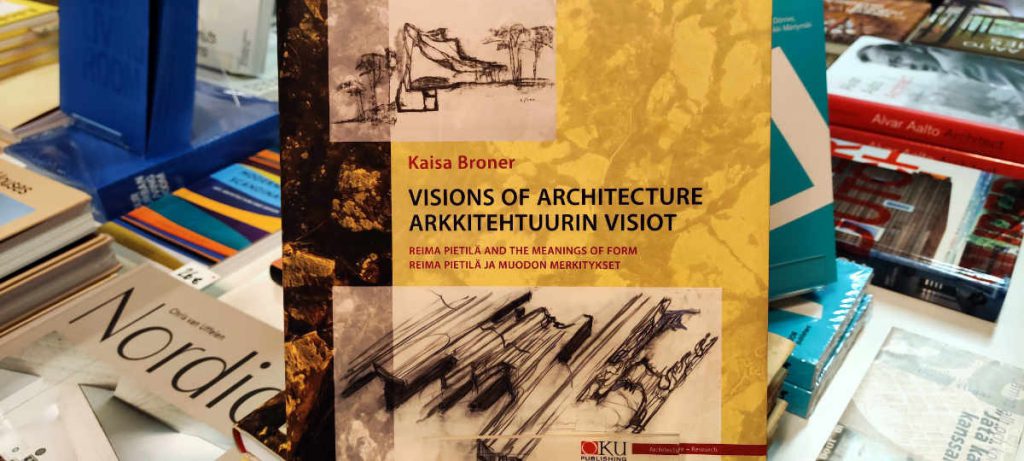
Kaisa Broner. 2019. Visions of Architecture: Reima Pietilä and the Meanings of Form. Arkkitehtuurin visiot: Reima Pietilä ja muodon merkitykset. Helsinki: OKU Publishing. Link to the product page.

